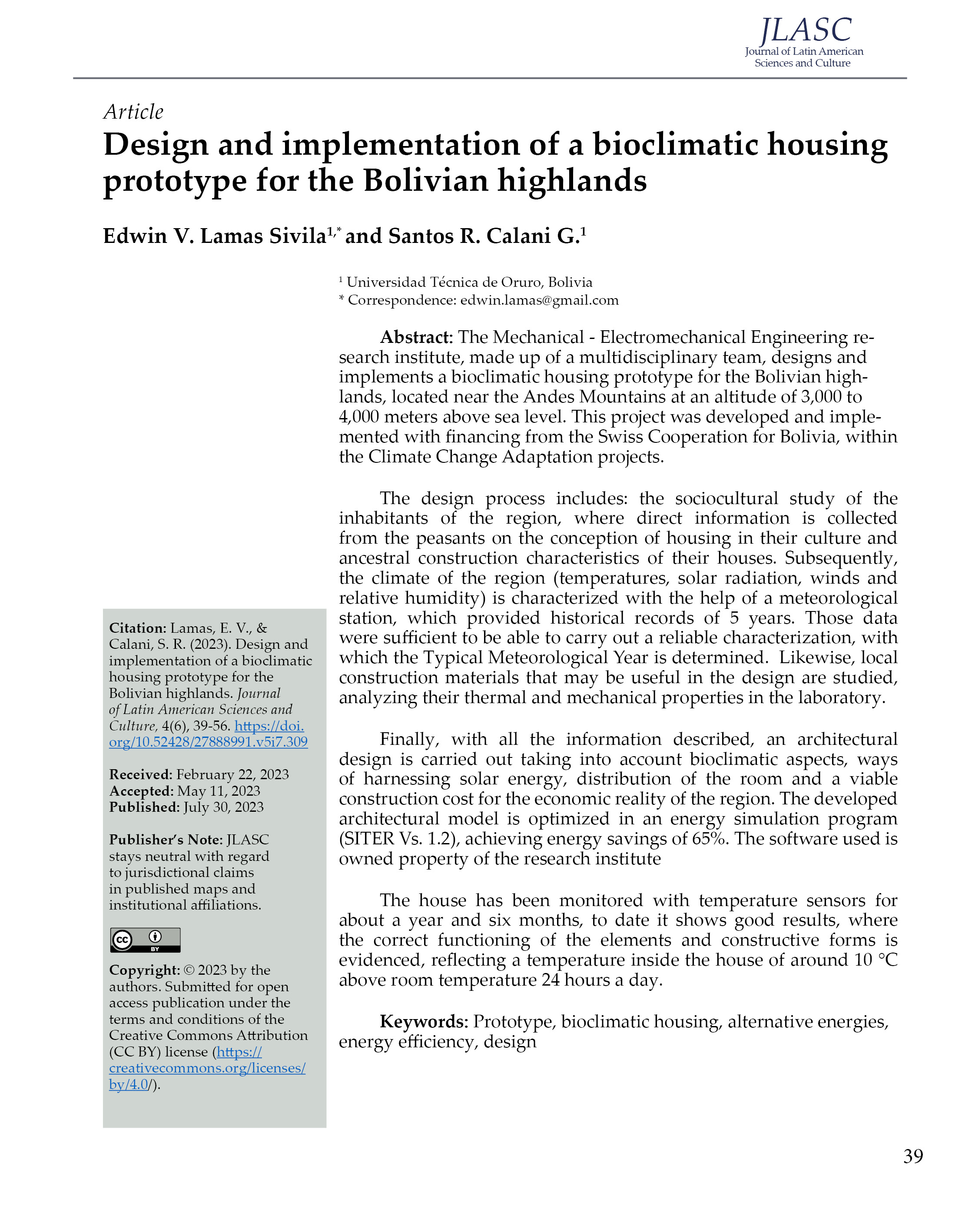Design and implementation of a bioclimatic housing prototype for the Bolivian highlands
DOI:
https://doi.org/10.52428/27888991.v5i7.309Palabras clave:
Prototipo, vivienda bioclimática, energías alter- nativas, eficiencia energética, diseño.Resumen
El instituto de investigación de Ingeniería Mecánica - Electromecánica compuesto por un equipo multidisciplinario, diseña e implementa un prototipo de vivienda bioclimática para el altiplano de Bolivia, ubicado cerca de la cordillera de los andes a una altitud de 3000 a 4000 msnm. Proyecto desarrollado e implementado con financiamiento de la Cooperación Suiza para Bolivia, dentro los proyectos de Adaptación al Cambio Climático.
El proceso de diseño abarca: el estudio sociocultural de los habitantes de la región, donde se recopila información directa de los campesinos sobre concepción de las viviendas en su cultura y características constructivas ancestrales de sus viviendas. Posteriormente se caracteriza el clima de la región (temperaturas, radiación solar, vientos y humedad relativa) con la ayuda de una estación meteorológica los cuales brindan registros históricos de 5 años, suficientes para poder realizar una caracterización confiable, con lo cual se determina el año tipo meteorológico. Así mismo se estudian materiales de construcción local que puedan ser de utilidad en el diseño, analizando sus propiedades térmicas y mecánicas en laboratorio.
Finalmente, con toda la información descrita se procede a realizar un diseño arquitectónico tomando en cuenta aspectos bioclimáticos, formas de aprovechamiento de la energía solar, distribución de la habitación y un costo de construcción viables a la realidad económica de la región. Al modelo arquitectónico desarrollado, se optimiza en un programa de simulación energética (Siter Vs. 1.2) alcanzando un ahorro energético del 65%. El software utilizado en de propiedad del Instituto de Investigación de la Carrera.
La vivienda es monitoreada con sensores de temperatura durante ya alrededor de un año y seis meses, hasta la fecha muestra buenos resultados, donde se evidencia el correcto funcionamiento de los elementos y formas constructivas, reflejando una temperatura dentro la vivienda de alrededor de 10 °C superior a la temperatura ambiente durante las 24 horas del día.
Descargas
Citas
UMSA, Universidad Mayor de San Andres. Geomagnetism and meteorology labora-tory in Patacamaya. La Paz: sn, 2006 - 2016.
SENAMHI. National Service of meteorology and hydrology. [Online] June 10, 2017. [Cited on: June 10, 2017.] http://www.senamhi.gob.bo.
ASHRAE, Handbook of Fundamentals. American Society of Heating Refrigerating and Air-Conditioning Engineers, Inc.Atlanta: sn, 2001.
Tables of solar altitude and azimuth; Intensity and solar heat gain tables. Stephen-son, DG 1967, Division of Building Research, National Research Council of Canada, Ot-tawa No 243.
Benford, F. and JE Bock,. A Time Analysis of Sunshine. Trans. Am. Illumin. : Eng. Soc., 1939. 200.
QUANTIFICATION OF SOLAR ENERGY FOR THE CITY OF ORURO BASED ON THE SOLARIMETRIC DATA OF THE METEOROLOGICAL STATION OF THE CARRERA DE ING. MECHANICS ELECTROMECHANICS. Edgar, Peñaranda Munoz. 2013, p. 9.
ENERGY, U S Department of Energy Pluss. [Online] September 10, 2014.
http://apps1.eere.energy.gov/buildings/energyplus/weatherdata_about.cfm.
John A. Duffie, William A. Beckman. Solar Engineering of Thermal Processes. United States of America: acid-free paper., 2013.
https://doi.org/10.1002/9781118671603 DOI: https://doi.org/10.1002/9781118671603
ORT, Faculty of Architecture University. Manual of solar thermal energy and associ-ated installations. Uruguay: Grafinel Press, 2009.
The Interrelationship and Characteristic. Liu, BYH and RC Jordan,. 1960, Solar En-ergy, p. Four.
J. Pinazo, "Air Conditioning Manual Volume II", Polytechnic University of Valencia, Spain - 1996.

Descargas
Publicado
Cómo citar
Número
Sección
Licencia
Derechos de autor 2022 Edwin Lamas

Esta obra está bajo una licencia internacional Creative Commons Atribución 4.0.
Los autores/as que publiquen en esta revista aceptan las siguientes condiciones: Los autores/as conservan los derechos de autor y ceden a la revista el derecho de la primera publicación, con el trabajo registrado con la licencia de atribución de Creative Commons 4.0, que permite a terceros utilizar lo publicado siempre que mencionen la autoría del trabajo y a la primera publicación en esta revista. Los autores/as pueden realizar otros acuerdos contractuales independientes y adicionales para la distribución no exclusiva de la versión del artículo publicado en esta revista (p. ej., incluirlo en un repositorio institucional o publicarlo en un libro) siempre que indiquen claramente que el trabajo se publicó por primera vez en esta revista. Se permite y recomienda a los autores/as a compartir su trabajo en línea (por ejemplo: en repositorios institucionales o páginas web personales) antes y durante el proceso de envío del manuscrito, ya que puede conducir a intercambios productivos, a una mayor y más rápida citación del trabajo publicado.








